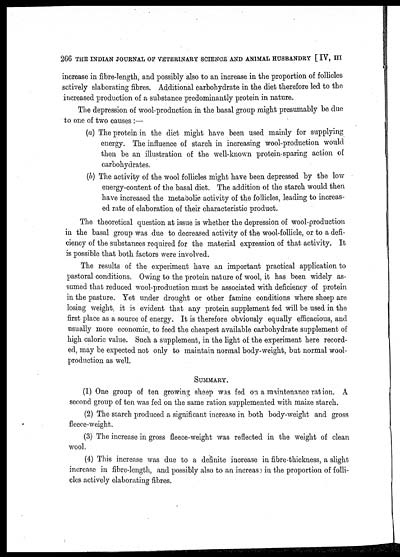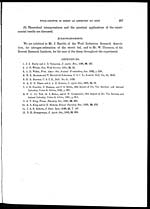Medicine - Veterinary > Veterinary colleges and laboratories > Indian journal of veterinary science and animal husbandry > Volume 4, 1934 > Original articles > Wool-growth in sheep as affected by the carbohydrate-content of the diet
(296) Page 266
Download files
Individual page:
Thumbnail gallery: Grid view | List view

266 THE INDIAN JOURNAL OF VETERINARY SCIENCE AND ANIMAL HUSBANDRY [ IV, III
increase in fibre-length, and possibly also to an increase in the proportion of follicles
sctively elaborating fibres. Additional carbohydrate in the diet therefore led to the
increased production of a substance predominantly protein in nature.
The depression of wool-production in the basal group might presumably be due
to one of two causes :—
(a) The protein in the diet might have been used mainly for supplying
energy. The influence of starch in increasing wool-production would
then be an illustration of the well-known protein-sparing action of
carbohydrates.
(b) The activity of the wool follicles might have been depressed by the low
energy-content of the basal diet. The addition of the starch would then
have increased the metabolic activity of the follicles, leading to increas-
ed rate of elaboration of their characteristic product.
The theoretical question at issue is whether the depression of wool-production
in the basal group was due to decreased activity of the wool-follicle, or to a defi-
ciency of the substances required for the material expression of that activity. It
is possible that both factors were involved.
The results of the experiment have an important practical application to
pastoral conditions. Owing to the protein nature of wool, it has been widely as-
sumed that reduced wool-production must be associated with deficiency of protein
in the pasture. Yet under drought or other famine conditions where sheep are
losing weight it is evident that any protein supplement fed will be used in the
first place as a source of energy. It is therefore obviously equally efficacious, and
usually more economic, to feed the cheapest available carbohydrate supplement of
high caloric value. Such a supplement, in the light of the experiment here record-
ed, may be expected not only to maintain normal body-weight, but normal wool-
production as well.
SUMMARY.
(1) One group of ten growing sheep was fed on a maintenance ration. A
second group of ten was fed on the same ration supplemented with maize starch.
(2) The starch produced a significant increase in both body-weight and gross
fleece-weight.
(3) The increase in gross fleece-weight was reflected in the weight of clean
wool.
(4) This increase was due to a definite increase in fibre-thickness, a slight-
increase in fibre-length, and possibly also to an increase in the proportion of folli-
cles actively elaborating fibres.
Set display mode to: Large image | Zoom image | Transcription
Images and transcriptions on this page, including medium image downloads, may be used under the Creative Commons Attribution 4.0 International Licence unless otherwise stated. ![]()
| Permanent URL | https://digital.nls.uk/75234604 |
|---|
| Description | Covers articles from 1934. |
|---|




